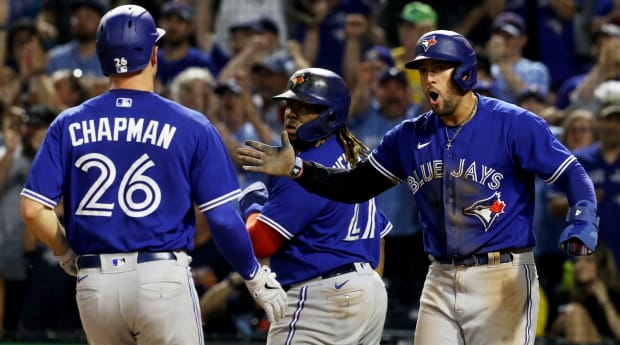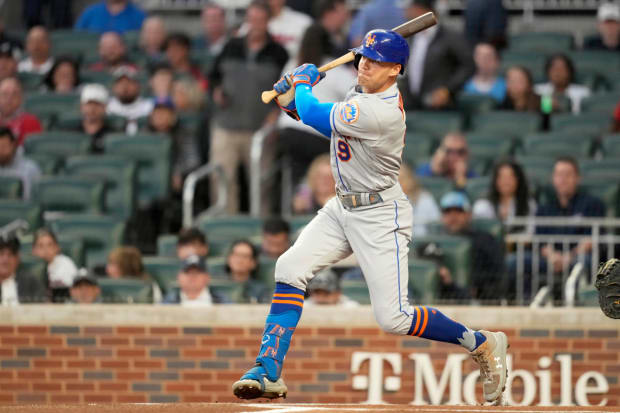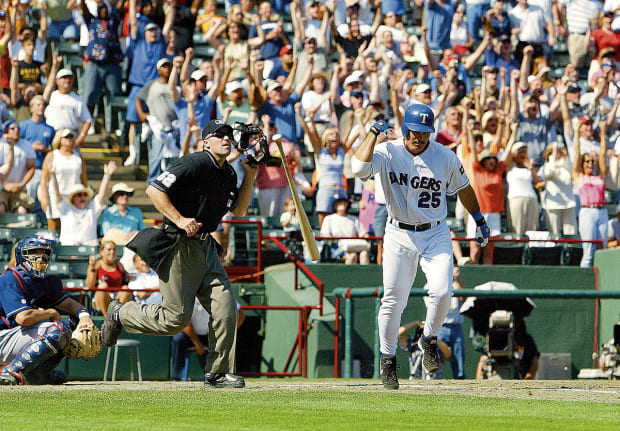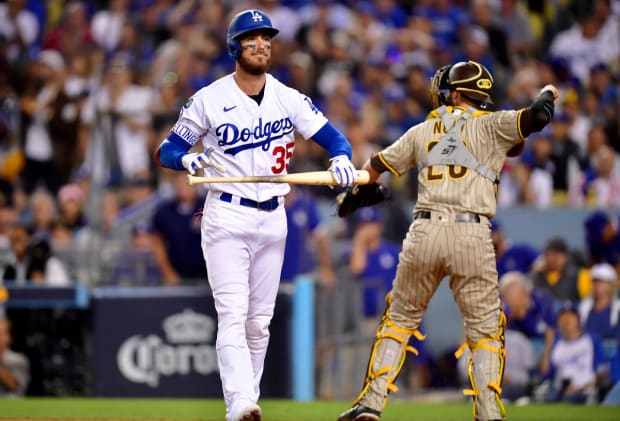
Charles LeClaire/USA TODAY Sports
Earlier this week, the Blue Jays and Mariners made a fascinating trade. Toronto sent outfielder Teoscar Hernández, one of its best hitters, to Seattle for righthander Erik Swanson and minor-league lefthander Adam Macko.
Hernández is projected to earn $14.1 million in 2023 via arbitration, according to MLB Trade Rumors, before becoming a free agent after next season. Swanson, meanwhile, is under club control for three more years and will get an estimated $1.4 million in his first year of arbitration. The trade is certainly a cost-saving move for the Blue Jays, but that isn’t a bad thing in this case, so long as they use the roughly $12.7 million they are saving to improve other parts of their roster.
Toronto entered the 2022 season facing great expectations after it traded for third baseman Matt Chapman and signed starting pitchers Kevin Gausman and Yusei Kikuchi. Despite the team’s first-round playoff exit and some of its key players underperforming, the Blue Jays mostly lived up to the hype. They scored the second most runs per game (4.78) and tied for the third best record (92–70) in the American League during the regular season.
Still, they were not without their faults. Their lineup was too right-handed, which made it easier for opponents to game plan against them, and their pitching staff lacked the depth required to make a deep postseason run. These problems have not gone away with the trade of Hernández, whose absence makes them no less right-handed—his projected replacement in their lineup, per Roster Resource, is the veteran Whit Merrifield, another righty batter—and far less threatening. Hernández has hit 121 home runs in the 583 games he’s played over the last five years. That includes the 16 he smacked in 50 games the pandemic-shortened 2020 season. Across that five-year span, when you adjust what he did in ’20 to a full 162-game schedule, Hernández averaged 133 games played and 28 home runs per season. Swanson, who had a 1.68 ERA in 57 appearances in 2022, does improve the bullpen, but if you look at this as just a straight swap, Toronto is worse now than it was before the trade.
That’s why this move cannot be evaluated in a vacuum. The Blue Jays aren’t punting, not with Vladimir Guerrero Jr. and Bo Bichette under club control for three more seasons and not after trading for Chapman and signing Gausman, George Springer and José Berríos to long-term deals. Instead, this is the start of a string of deals that ideally will address their two main roster holes: lefty batters and pitching depth. Let’s take a look at how the Blue Jays can do that while staying under the first luxury tax threshold, which is $233 million for the upcoming season. In other words, let’s spend someone else’s money—well, in this case a corporation’s money because the Blue Jays are owned by Rogers Communications—to assemble the best team possible. For this exercise, I’ll be using MLB Trade Rumors for estimated salaries after arbitration, Spotrac’s market value calculations for current free agents and Roster Resource for payroll and luxury tax projections. Right now, Toronto’s estimated player payroll for 2023 is $176 million and luxury tax payroll is about $201 million, leaving it with roughly $32 million to play with.
The biggest issue for this team, especially after trading Hernández, is its lineup. Cavan Biggio is the only left-handed batter on the roster who could reasonably be expected to start, but he lost his job as the starting second baseman to Santiago Espinal, who enjoyed a breakout season and was named to the All-Star team. Two things working in Biggio’s favor are his positional flexibility and the new rule banning infield shifts, but as things stand, he’s likely to fill more of a utility role than be in the lineup every day, which leaves Toronto with an all right-handed lineup.
Entering the offseason, Sports Illustrated’s Will Laws and Nick Selbe ranked the top 50 free agents, and only nine of them bat left-handed. Two of them, Anthony Rizzo (No. 19) and Joc Pederson (No. 23), are no longer available, leaving the Blue Jays with a limited pool of players to sign.
That means their top priority should be to sign either center fielder Brandon Nimmo (No. 10 on the SI 50) or left fielder Andrew Benintendi (No. 13), two of the best on-base options available. Either player would slot in nicely atop the lineup, ahead of Guerrero, Bichette and Chapman. Nimmo, who turns 30 in March, has the better track record, albeit with some injury concerns, while Benintendi, 28, is younger and might have the higher ceiling. Nimmo’s market value is $106 million for five years, an average annual value of $21.1 million, while Benintendi’s is $104.4 million for six years, an AAV of $17.3 million.
Let’s go with Nimmo, for two reasons:
1) He plays center field. This would slide Springer to right field, a less physically demanding position, which would hopefully help him avoid injuries as he ages.
2) Nimmo is the more consistent player. His adjusted OPS over the last five seasons is 134, meaning he’s been 34% better than the league average hitter, and only once in that span (2019) was his OPS+ below 130. In that “down year,” he still had a .375 on-base percentage and a 111 OPS+. Benintendi’s adjusted OPS over the last five years is 108, and even if you exclude his 25 OPS+ in the 14 games he played during the pandemic season, his best two years (123 OPS+ in ’18 and 120 OPS+ in ’22) are below Nimmo’s career mark (130 OPS+).

Dale Zanine/USA TODAY Sports
That leaves the Blue Jays with $10.9 million in luxury tax space, enough to sign one more veteran left-handed batter. My choice here is Michael Brantley, whose market value is somewhat diminished because of his age (he’ll be 36 in May) and his injury status; he missed the final 101 days of the regular season and the players due to right shoulder discomfort. When healthy, though, Brantley is one of the most consistent hitters in the league. His adjusted OPS has ranged from 119 to 127 in each of the last five seasons. That production would be a bargain for Toronto at his market value of two years and $16 million.
With the $2.9 million remaining, the Blue Jays could do one of three things: sign one or two veteran relief pitchers to the league minimum salary ($720,000), one veteran starter for an AAV of roughly $3 million—they’d find a way to shed the $100,000 to stay below the threshold if needed—or make a trade. For the sake of this exercise, let’s go with the third option because hypothetical trades are more fun.
The Blue Jays have two starting catchers on their roster (Alejandro Kirk and Danny Jansen) and a third (Gabriel Moreno, who is the third-best prospect in all of baseball, per FanGraphs) ready for the majors. Following Yadier Molina’s retirement, the Cardinals are the obvious trade partner here. I used the Baseball Trade Values trade simulator and came up with this deal, which was accepted.
Blue Jays trade: catcher Alejandro Kirk
Cardinals trade: outfielder Lars Nootbaar and righthander Dakota Hudson
Both Kirk and Nootbaar are pre-arbitration guys who will make roughly the same amount next season, while Hudson is projected to get $2.7 million after arbitration. Nootbaar provides yet another lefty bat for Toronto and solid outfield defense, while Hudson could easily slot into the backend of the rotation. Hudson, 28, struggled in 2022, but it was his first season back from Tommy John surgery. He still has electric stuff, and if he can learn to better control the movement on his pitches and cut down on the walks, he would be a valuable addition.
Kirk was an All-Star and a Silver Slugger in 2022, and trading him wouldn’t be an easy decision, especially because he is so young (24), affordable and under club control for the next four seasons. But, if Moreno is as good as expected, he’ll be Toronto’s catcher of the future, with Jansen as a really good stopgap or tandem option to take some of the pressure off Moreno.
Here’s what the Blue Jays’ Opening Day roster would look like after making this moves:
Lineup:
1. George Springer, RF
2. Brandon Nimmo, CF
3. Vladimir Guerrero Jr., 1B
4. Bo Bichette, SS
5. Michael Brantley, DH
6. Matt Chapman, 3B
7. Danny Jansen, C
8. Lourdes Gurriel Jr. or Lars Nootbaar, LF
9. Santiago Espinal, 2B
Bench:
C: Gabriel Moreno
INF/OF: Cavan Biggio
INF/OF: Whit Merrifield
OF: Gurriel or Nootbaar
Yes, there would be an odd man out here with either Gurriel, Brantley or Nootbaar, but that’s not necessarily a bad thing considering the injury histories of Springer, Nimmo and Brantley. Also, the Blue Jays could take advantage of some platoons, with right-handed hitters Gurriel and Merrifield and lefties Nootbaar and Brantley.
Meanwhile, the rotation and bullpen would look something like this:
Rotation:
1. Alek Manoah, RHP
2. Kevin Gausman, RHP
3. José Berríos, RHP
4. Dakota Hudson, RHP
5. Mitch White or Yusei Kikuchi, LHP
Bullpen:
Jordan Romano, RHP
Erik Swanson, RHP
Yimi Garcia, RHP
Anthony Bass, RHP
Tim Mayza, LHP
Adam Cimber, RHP
Zach Pop, RHP
White or Kikuchi, LHP
The Blue Jays could decide to sign Benintendi instead of Nimmo or a veteran starter instead of Brantley. They also could decide to trade Jansen instead of Kirk or to keep all three of their catchers for now. Either way, more moves are coming.
Quick programming note: We are off next Friday because of Thanksgiving. We’ll be back in your inbox the following Friday to preview the Winter Meetings.
Have any questions or comments for our team? Send a note to mlb@si.com.
1. THE OPENER

Bob Rosato/Sports Illustrated
“Five hundred sixty-nine home runs, 3,020 hits and one positive steroid test. That is the Hall of Fame candidacy of Rafael Palmeiro in one sentence. He gets a second chance Dec. 4. He is one of eight players on the Contemporary Baseball Era ballot—the only one with a failed test on his playing record.”
That’s Tom Verducci, writing in his story from earlier this week. He interviewed Palmeiro about the former slugger’s Hall of Fame case and failed PED test.
Rafael Palmeiro Opens Up About His Steroid-Tainted Legacy by Tom Verducci
Performance-enhancing drugs thus far have cost him his place in the Hall of Fame. Next month, he’ll get another shot at making it via the Contemporary Baseball Era ballot.
2. ICYMI
A lot has happened since the last newsletter. Let’s get you caught up on some of our best stories:
MLB GMs Weighing Potential Effects of Rule Changes on Roster Construction by Emma Baccellieri
Every rule change instituted for the 2023 season, from the pitch clock to the shift ban, has two sides to it. And executives need to consider everything when building a team.
Astros Owner Should Be Ashamed of His Carelessness by Stephanie Apstein
Jim Crane has shown a shocking amount of disrespect to two of the men who oversaw Houston’s return to the top.
The 2022 World Series Is a Lesson for the Rest of Baseball by Tom Verducci
There were a lot of differences between the Phillies and Astros in this series, but there were a few key factors that set the two apart.
The Five Best Fits for Aaron Judge by Nick Selbe
Every team would like to sign the AL MVP. But only a precious few actually make sense for him.
Ranking MLB’s Top 50 Free Agents, With Signing Predictions by Will Laws and Nick Selbe
The offseason is officially here, and this year’s free-agency class features a record-setting slugger alongside star shortstops. See how they stack up and where they could land.
3. WORTH NOTING from Matt Martell

Gary A. Vasquez/USA TODAY Sports
Tonight at 8 p.m. ET is the deadline for teams to tender contracts to their arbitration eligible players. The most notable player to keep an eye on here is Dodgers center fielder Cody Bellinger, who is projected to earn $18.1 million in arbitration despite his offensive struggles in the three years since he won the NL MVP in 2019. If Los Angeles does not tender Bellinger a contract, he would become a free agent, and he’d immediately become one of the most fascinating players available. Bellinger’s upside is undeniable. He’s only 27 and is still not too far removed from being the best player in the league. Teams could also look at his injuries in ’20 and ’21 as reasons to believe that he could have a resurgence next season. Then again, Bellinger’s decline hasn’t been limited to one rough year. Over the last three seasons, he’s slashed .203/.272/.376 with a 74 OPS+. After hitting 47 home runs in 156 games during his MVP season, he combined for 41 homers across 295 games in the three years since.
4. TRIVIA from Matt Martell
Paul Goldschmidt is the sixth Cardinals first baseman to win the MVP award. Who are the other five?
5. THE CLOSER from Nick Selbe
MLB’s awards season has come and gone, and while much ink was spent and hot air used up on MVP debates, the end results were fairly decisive. But this is not the forum to rehash the two (very deserving) winners, as both Aaron Judge and Paul Goldschmidt had outstanding performances supremely worthy of hardware. The down ballot vote-getters won’t receive much attention, but their names play just as important a role in telling the story of the season as the winners do. Six months ago, how would you have responded to hearing that Guardians second baseman Andrés Giménez finished higher in the voting (sixth) than Mike Trout (eighth)? Or that batting champion Luis Arraez (13th) finished ahead of Vladimir Guerrero Jr. (16th)? Or that Rockies reliever Daniel Bard (!!) received a ninth-place vote? Their respective MVP finishes might not garner many headlines, they’re worthy of recognition all the same.







